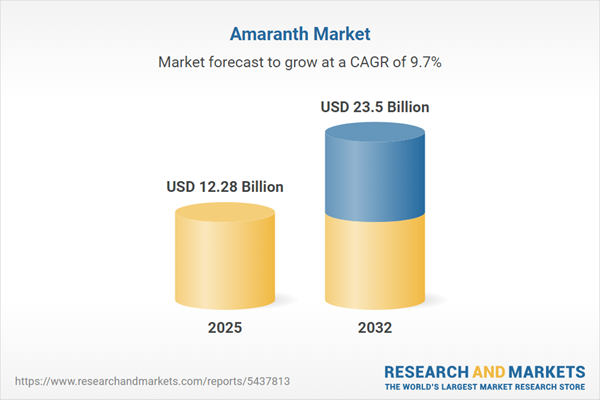Speak directly to the analyst to clarify any post sales queries you may have.
As procurement and innovation priorities shift under clean-label requirements and sustainability mandates, the amaranth market is taking on strategic significance. Senior leaders are examining their sourcing and R&D strategies to remain compliant while meeting evolving customer demand for specialty ingredients.
Amaranth Market Snapshot: Size, Growth, and Core Drivers
The global amaranth market is valued at USD 11.21 billion in 2024, projected to rise to USD 12.28 billion in 2025, with expectations of reaching USD 23.50 billion by 2032. This growth is propelled by a compound annual growth rate of 9.69%. Widespread demand spans sectors such as food, personal care, pharmaceuticals, and animal nutrition, fueled by rising interest in clean-label components and sustainable sourcing. Procurement teams are leveraging enhanced processing solutions to keep pace with stricter compliance, while tailored ingredient innovation enables a proactive response to regulatory and commercial shifts.
Scope & Segmentation in the Amaranth Market
This report supports procurement, supply chain, and R&D executives by supplying granular analysis across all critical industry segments. Strategic segmentation addresses resilience, compliance, and adaptive portfolio management, with a focus on cross-functional impact:
- Form: Access to conventional and organic amaranth supports alignment with current and future sustainability mandates, equipping organizations to navigate evolving environmental regulations effectively.
- Application: Covers a wide variety of end uses, including animal feed, bakery products, snacks, personal care, pharmaceuticals, and nutritional products, each influencing compliance requirements and product development initiatives.
- Product Type: Range includes raw and roasted seeds, multiple grades of flour, and specialty oils such as refined and cold-pressed, facilitating compatibility with specific commercial processes and operational needs.
- Distribution Channel: E-commerce, supermarkets, and wholesale platforms drive digital transformation and enhance operational efficiency across ingredient sourcing strategies.
- Geographical Coverage: Comprehensive regional insights span the Americas, Europe, Middle East and Africa, and Asia-Pacific, reflecting how local regulations and consumer expectations impact supply chain agility.
- Leading Companies: Industry benchmarks set by Archer-Daniels-Midland Company, Cargill, Ingredion, Roquette Frères, BENEO GmbH, Glanbia, Kerry Group, The Hain Celestial Group, Döhler GmbH, and Ardent Mills showcase leadership in innovation and supply reliability.
Key Takeaways for Strategic Stakeholders
- Clean-label expectations are advancing the strategic relevance of the amaranth market, particularly for allergen-conscious product development and diversification across ingredient portfolios.
- Processing advancements broaden the scope of functional applications, allowing organizations to pivot efficiently in response to shifting consumer and compliance demands.
- Investments in digital supply chain tools are optimizing traceability and transparency, helping procurement leaders meet regulatory expectations and mitigate risk.
- Collaborations in R&D and cross-sector partnerships in bakery and nutritional products are driving competitive product differentiation and reducing development cycles.
- Digital procurement practices and growing e-commerce adoption are enhancing flexibility and supplier resilience, critical for adaptable ingredient sourcing.
- Industry-wide collaborations such as mergers and alliances are essential for maintaining ongoing compliance as global sourcing and trade requirements evolve.
Tariff Impact: Navigating Shifting Trade Dynamics
Procurement strategies are recalibrating in response to variable U.S. tariffs, most notably in Latin America and Asia-Pacific regions. Emphasis on broadening supplier networks and strengthening partnerships has become central to risk management, while flexible inventory practices reinforce supply security in a dynamic global environment.
Methodology & Data Sources
This analysis employs a multi-source research approach, including direct interviews with senior executives, regulatory documentation, and global trade data. The combination of these sources ensures actionable, validated insights that support effective planning for senior decision-makers.
Why This Amaranth Market Report Matters
- Segment-focused analytics empower leaders to make agile procurement decisions, supporting rapid adaptation to new technologies and regulatory changes across the specialty ingredient sector.
- Comprehensive intelligence enables senior executives to anticipate sector shifts, optimize resources throughout sourcing and R&D, and strengthen operational response to volatility.
- Access to scenario-planning tools strengthens risk management and builds resilience, ensuring continuity in supply chains during periods of trade or sourcing disruption.
Conclusion
Strategically integrating amaranth into procurement and innovation workflows can enhance growth and risk mitigation outcomes. Continued agility and collaboration are key as specialty ingredient markets and their regulations evolve.
Additional Product Information:
- Purchase of this report includes 1 year online access with quarterly updates.
- This report can be updated on request. Please contact our Customer Experience team using the Ask a Question widget on our website.
Table of Contents
3. Executive Summary
4. Market Overview
7. Cumulative Impact of Artificial Intelligence 2025
Companies Mentioned
The companies profiled in this Amaranth market report include:- Archer-Daniels-Midland Company
- Cargill, Incorporated
- Ingredion Incorporated
- Roquette Frères
- BENEO GmbH
- Glanbia PLC
- Kerry Group PLC
- The Hain Celestial Group, Inc.
- Döhler GmbH
- Ardent Mills, LLC
Table Information
| Report Attribute | Details |
|---|---|
| No. of Pages | 183 |
| Published | November 2025 |
| Forecast Period | 2025 - 2032 |
| Estimated Market Value ( USD | $ 12.28 Billion |
| Forecasted Market Value ( USD | $ 23.5 Billion |
| Compound Annual Growth Rate | 9.6% |
| Regions Covered | Global |
| No. of Companies Mentioned | 11 |









